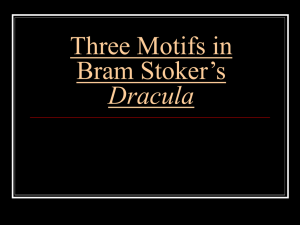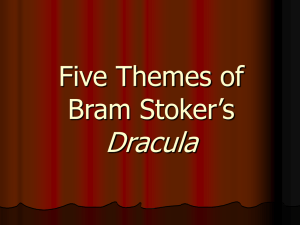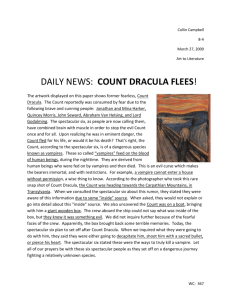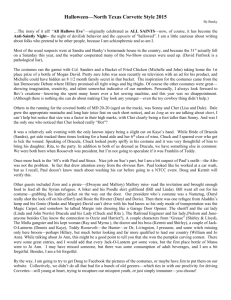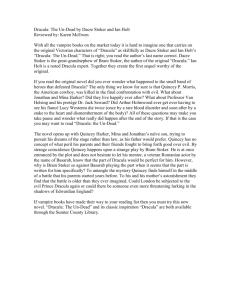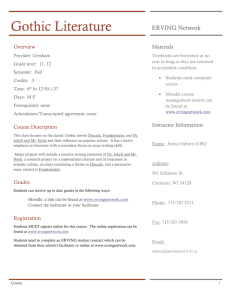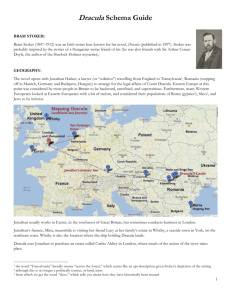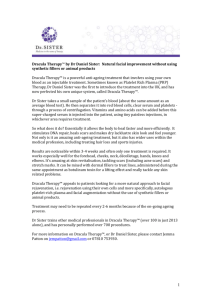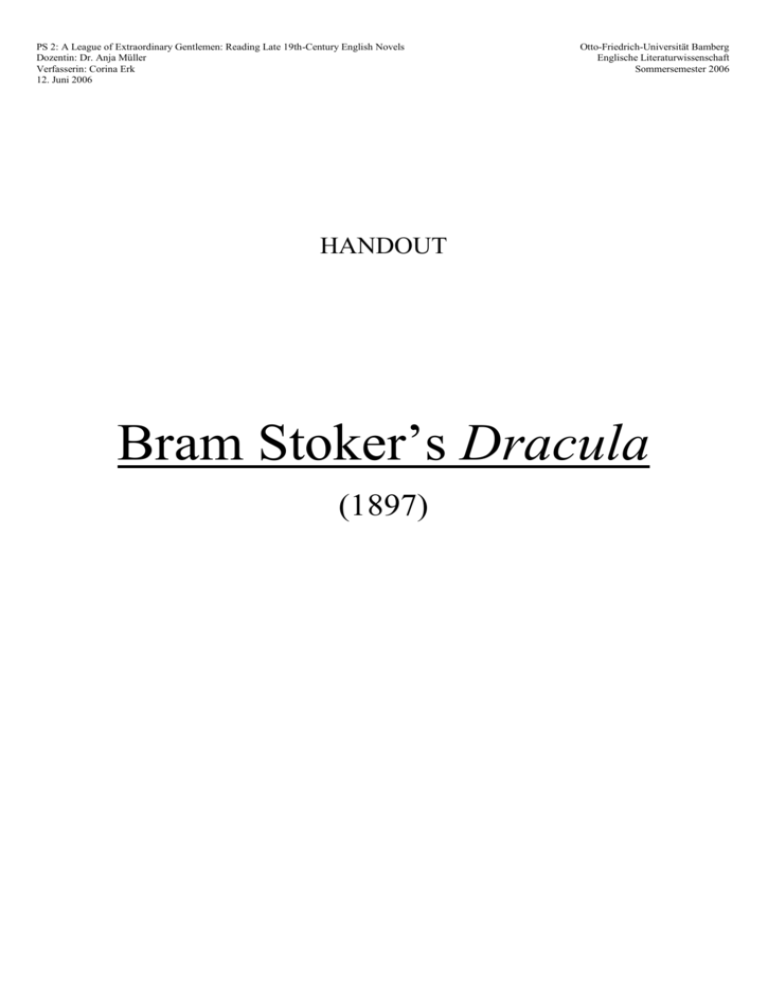
PS 2: A League of Extraordinary Gentlemen: Reading Late 19th-Century English Novels
Dozentin: Dr. Anja Müller
Verfasserin: Corina Erk
12. Juni 2006
Otto-Friedrich-Universität Bamberg
Englische Literaturwissenschaft
Sommersemester 2006
HANDOUT
Bram Stoker’s Dracula
(1897)
PS 2: A League of Extraordinary Gentlemen: Reading Late 19th-Century English Novels
Dozentin: Dr. Anja Müller
Verfasserin: Corina Erk
12. Juni 2006
Otto-Friedrich-Universität Bamberg
Englische Literaturwissenschaft
Sommersemester 2006
Bram Stoker’s Dracula (1897)
"Film-makers and writers continually resurrect the count, infusing him with fresh blood, producing and
reproducing new variations that simultaneously feed and create a seemingly insatiable public appetite. No other monster
has endured, and proliferated, in quite the same way – even if we now seem to prefer interviewing, rather than staking,
our vampires."1
1. Byron Glennis: “Introduction” (p. 1-21)
-
-
-
-
-
-
-
-
the Gothic is the genre with which Dracula is most closely identified
transgression as a central focus of the Gothic plot all barriers are broken down, all secret spaces
penetrated
Dracula belongs to the Gothic in its association with the disruption and transgression of both social and
psychic limits and boundaries
the count as the embodiment of transgression as shapeshifter he has no stable fixed identity; as
vampire he straddles the boundaries between life and death; as undead he is both absent and present
various Gothic effects in Dracula: pleasure produced by the freedom from constraints consequent
upon transgression, from the release of energies and desires normally repressed in the interest of both
social and mental stability; anxiety and horror which inform the responses of the characters and
vicariously, perhaps, the readers
effects of transgression: produces not only pleasure but simultaneously anxiety and fear by projecting an
uncontrollable and overwhelming power which threatens not only the loss of sanity, honour, property or
social standing but the very order which supports and is regulated by the coherence of those terms
at stake in Dracula: undermining and blurring of all the psychic and social categories upon which the
security and comfort of the middle-class Victorian world depend
horror is caused by the disruption of categories, the confusion of boundaries, the undermining of all the
middle-class values the characters in the story hold dear part of the horror is directed at Mina for her
apparent complicity and for her momentary lapse which allows the emergence of her own transgressive
desires
Dracula today: proliferation of vampires in the 20th century vampire has developed into a full-scale
industry numerous rewritings of Dracula in film and literature; vampire sites on the internet; vampire
devotees can be fitted with some impressive vampire like teeth; vampire has been most notoriously
reconstructed as tender love in Francis Coppola’s Bram Stoker’s Dracula; vampire porn film like Jamie
Gillis’s Dracula Exotica, where the influence of true love turns Dracula from bat into dove
2. David Punter: “Dracula and Taboo” (p. 22-29)
-
-
-
-
1
Punter calls Dracula a myth
Dracula’s relationship to the world is the culmination of tyranny seeks not only the survival of
himself but of his house as the nobleman’s real powers disappear, he becomes invested with semisupernatural abilities
Stoker’s Dracula as a modification of pre-bourgeois fears of tyrannical violence imaged in terms of the
primal fear of blood-sucking
distinctive text for the social and psychological dilemmas of the late nineteenth century location of
psychological fears specifically within late Victorian society powerful record of social pressures
anxieties
Dracula as a dramatised conflict of social forces and attitudes: opposite the strength of the vampire is
the strength of bourgeois marital relations and sentimental love
Byron, Glennis, ed. Dracula. New York: St. Martin's, 1999. page?
2
PS 2: A League of Extraordinary Gentlemen: Reading Late 19th-Century English Novels
Dozentin: Dr. Anja Müller
Verfasserin: Corina Erk
12. Juni 2006
-
-
Otto-Friedrich-Universität Bamberg
Englische Literaturwissenschaft
Sommersemester 2006
structural opposites: Dracula stands for lineage, the principal group of characters for family; Dracula for
the wildness of night, they for the security of day; Dracula for unintelligible and bitter passion, they for
the sweet and reasonable emotions …
main opposite: between Dracula and his arch-enemy Van Helsing
for Dracula there’s no final satisfaction for his nature is desire
text manifests a socially revealing ambivalence:
Dracula’s point of view
promise of true union which transcends death
his victims experience joy at the moment of
consummation
the group defeats him through hard work and diligent Dracula exists and exerts power through right
application the weapons of a class which derives its immemorial
existence from labour
bourgeois point of view
Dracula as a manic individualist
he stands for sexual perversion and sadism
-
-
-
-
the myth in Dracula is an inversion of Pauline Christianity, in that Dracula promises the real
resurrection of the body, but disunited from the soul
where taboo sets up certain boundaries and divisions which enable society to function without
disruption, Dracula blurs those lines between man and beast, and between man and God by daring to
partake of immortal life and by practising a corrupt superhuman form of love
in his figure are delineated many primitive fears: he is a shape-changer, a merger of species, the
harbinger of ethnic collapse
in Stoker’s text: the traces of the illimitable desire which turns love into possession and demands
incorporation of the love-object
IN SHORT:
Punter argues in favour of Freudian and Marxist theses
the power of Dracula derives from its dealings with taboo, which sets up boundaries that enable the
society to function smoothly
Dracula blurs these boundaries, echoing society’s fears of degeneration
the core fantasy of the text is emerging from the Oedipal complex and the efforts of the vampire hunters
to destroy Dracula as the battle of the sons against the father for the affections of the mother
in Freudian terms: Dracula as the endless desire of the in Marxist terms: Dracula as the final aristocrat set
unconscious for gratification
against the bourgeois late Victorian family
3. Phyllis A. Roth: “Suddenly Sexual: Women in Bram Stoker’s Dracula” (p. 30-42)
-
-
-
-
-
the facile and stereotypical dichotomy between the dark woman and the fair, the fallen and the idealised
is obvious in Dracula contrast between sensual and sexless woman the suddenly sexual woman is
self-righteously persecuted in the text
passages in which the ‘New Woman’ who is sexually aggressive is verbally assaulted
explicit and uninhibited sexuality in Dracula, e.g.: the scene in which Dracula slits open his breast and
forces Mina Harker to drink his blood
only relations with vampires are sexualised in the novel sexuality is unthinkable in ‘normal relations’
between the sexes all ‘human’ relationships are spiritualised only when Lucy becomes a vampire
is she allowed to be voluptuous
vampirism is associated not only with death and immortality but is equivalent to sexuality vampirism
is a disguise for greatly desired and equally strong feared fantasies
split between the sexual vampire family and the asexual Van Helsing group, but: Jonathan, Van Helsing,
Seward and Holmwood are attracted to the vampires and sexuality
3
PS 2: A League of Extraordinary Gentlemen: Reading Late 19th-Century English Novels
Dozentin: Dr. Anja Müller
Verfasserin: Corina Erk
12. Juni 2006
-
-
-
-
-
-
Otto-Friedrich-Universität Bamberg
Englische Literaturwissenschaft
Sommersemester 2006
Dracula acts out the repressed fantasies of the others the others wish to do what he can do
identification with the aggressor on the part of the characters and the reader alike
Roth believes Lucy and Mina to be the same figure: the mother Lucy the more sexualised figure and
also more rejecting to two of the three ‘sons’ in the novel
Mina, on the other hand, is never described physically and is the opposite of rejecting: all the men
become her sons, symbolised by the naming of her actual son after them all
ambivalence towards the ‘mother’: 1. the men want to save Mina and prevent Dracula from getting her
2. by leaving her at the hospital while chasing Dracula, they expose her to the vampire on purpose
they want Dracula to get her
Jonathan has the role of a child when Dracula takes him away from the vampire women, he gives
them a child as substitute
Mina at the breast of the Count is identical to the vampire women whose desire is to draw out of the
male the fluid necessary for life
IN SHORT:
early Freudian reading of the text Roth argues that the hostility towards the sexualised woman suggest
that the driving fantasy may actually be pre-Oedipal and the primary desire is to destroy the threatening
mother
description of the emerging hostility towards the ‘New Woman’ in late Victorian society Roth moves
towards a feminist reading
4. Franco Moretti: “Dracula and Capitalism” (p. 43-54)
-
-
-
-
Dracula as an ascetic of terror: in him is celebrated the victory of the desire for possession over that of
enjoyment possession as such is insatiable and unlimited
Dracula as a rational entrepreneur who invests his gold to expand his dominion: to conquer the City of
London
Dracula does not like spilling blood but he needs it he sucks just as much as necessary and never
wastes a drop his desire is not to destroy the lives of others but to use them Dracula as a saver and
an upholder of the Protestant ethic
he has no shadow, his body exists but is incorporeal in comparison to Marx, who wrote of the
commodity: ‘sensibly supersensible’ it is impossible, physically, to estrange a man from himself, to
de-humanise him but: alienated labour, as a social relation, makes this possible there really exists
a social product which has no body which is money when Harker explores Dracula’s castle he finds
nothing but money the money that had been buried comes back to life, becomes capital and embarks
on the conquest of the world this is the main point in the novel
Marx thesis in comparison to Dracula:
‘Capital is dead labour which, vampire-like, lives a ‘dead’ person who yet manages to live thanks to
only by sucking living labour, and lives the more, the blood he sucks from the living
the more labour it sucks.’
‘the capitalist gets rich, not, like the miser, in Dracula’s victims’ strength becomes his strength
proportion to his personal labour and restricted the stronger the vampire gets, the weaker the
consumption, but at the same rate as he squeezes living become
out labour-power from others, […].’
-
the capitalist is ‘capital personified’ and must subordinate his private existence to the abstract and
incessant movement of accumulation, so Dracula is not impelled by the desire for power but by the
curse of power, an obligation he cannot escape his curse compels him to make ever more victims,
just as the capitalist is compelled to accumulate vampire as a metaphor of capital
4
PS 2: A League of Extraordinary Gentlemen: Reading Late 19th-Century English Novels
Dozentin: Dr. Anja Müller
Verfasserin: Corina Erk
12. Juni 2006
-
-
-
-
Otto-Friedrich-Universität Bamberg
Englische Literaturwissenschaft
Sommersemester 2006
Dracula as a monopolist: solitary and despotic his ambition is to subjugate the last vestiges of the
liberal era and destroy all form of economic independence does not restrict himself to incorporating
the physical and moral strength of his victims intends to make them his forever
the vampire, like monopoly, destroys the hope that one’s independence can one day be brought back
threatens the idea of individual liberty the 19th century bourgeois imagines monopoly in the guise of
Count Dracula, the aristocrat in order to establish free trade free competition has to destroy the
tyranny of feudal monopoly which was seen as a foreign threat in the England of the 19th century
therefore: Dracula is not British while his antagonists are in most cases British nationalism, the
defence to the death of the British civilisation, has a central role in Dracula
in that sense: the money of Dracula’s enemies is money that refuses to become capital, that wants not to
obey the profane economic laws of capitalism but to be used to do good money should be used to do
justice and should have a moral, anti-economic function
5. Judith Halberstam: “Technologies of Monstrosity: Bram Stoker’s Dracula” (p. 173-196)
5.1
-
-
-
-
-
-
Technologies of Monstrosity
Dracula as not only a monster but a technology of monstrosity he is otherness itself, a distilled
version of all others produced by and within fictional texts, sexual science and psychopathology
Dracula’s technology is also a technology of sex Dracula represents the hysterical woman, the
masturbating child and the perverse adult he economically condenses their sexual threat into one
body
the others that Dracula has absorbed and who live on in him take on the historically specific contours of
race, gender, class and sexuality they are the other side of a national identity that, in the 1890s,
coincided with a hegemonic ideal of bourgeois Victorian womanhood
writing and reading appear to provide a safe textual alternative to the sexuality of the vampire he is a
threat that must be diffused by discourse
the narrative episodes are taken by 4 characters (Jonathan and Mina Harker, Dr Seward, Lucy Westenra)
who are exclusively from England activities of reading and writing are crucial in this novel to the
establishment of a kind of middle-class hegemony and they are annexed to the productions of sexual
subjectivities
writing must be controlled since it represents the deployment of knowledge and power reading must
also be authorised and censored the vampire has no voice
5.2 Gothic Anti-Semitism: Degeneracy
-
-
the vampire bears some relation to the anti-Semite’s Jew
the monster Jew produced by 19th century anti-Semitism represents fears about race, class, gender,
sexuality and empire
connection between Stoker’s Gothic fiction and 19th century anti-Semitism
Dracula resembles the Jew of anti-Semitic discourse in several ways:
appearance
relation to money/ gold
parasitism
degeneracy
femininity
lack of allegiance to a fatherland
-
Dracula’s physiognomy is a particularly clear cipher for the specificity of his ethnic monstrosity
5
PS 2: A League of Extraordinary Gentlemen: Reading Late 19th-Century English Novels
Dozentin: Dr. Anja Müller
Verfasserin: Corina Erk
12. Juni 2006
-
Otto-Friedrich-Universität Bamberg
Englische Literaturwissenschaft
Sommersemester 2006
Dracula’s appearance resembles the description of other fictional Jews his face expresses Jewishness
and 19th century criminality and degeneration stereotypes were thought to be visualisable in those
days as there was the attempt to catalogue and demonstrate a propensity for degenerative behaviour by
reading bodies and faces
5.3. Gothic Anti-Semitism: Jewish Bodies/ Jewish Neurosis
-
-
-
-
-
-
-
Halberstam calls modern anti-Semitism ‘Gothic’ because it, too, unites and therefore produces the
threats of capital and revolution, criminality and impotence, sexual power and gender ambiguity, money
and mind within an identifiable form, the body of the Jew
in the novel: vampires are a race that weakens the stock of Englishness by passing on degeneracy and
the disease of blood list Dracula, as a monster, feeds upon English wealth and health
Dracula is surrounded by the odour of awful decay like the diseases attributed to the Jews as a race,
bodily odours, people assumed, marked them out as different
in the 1890s parasitism was linked to Jewishness Jews were said to spread syphilis, they were linked
to criminality and degeneration the Jewish body was constructed as parasite and as a corruption of
spirit that reveals itself upon the flesh the horror-generating disease-riddled body of the vampire
resembles to the anti-Semite’s ‘Jewish body’
vampirism and its psychotic form of zoophagy ( Renfield consumes birds) both make a pathology out
of threats to rationality made by means of excessive consumption and its relation to particular social and
sexual habits
according to anti-Semitism, the pathology of the Jews involved an absence of allegiance to a Fatherland,
a propensity for economic opportunism and, thus, a lack of social morality and a kind of morbid
selfishness Dracula’s need to ‘consume as many lives as he can’, his feminised because non-phallic
sexuality, and his ambulism that causes him to wander far from home in search of new blood mark him
with all the signs of a Jewish neurosis
Dracula, like the Jew, is parasitical upon the community’s health and wealth
IN SHORT:
Halberstam shows how the Gothic novel produces monstrosity as an aggregate of race, class and gender, in
order to demonstrate their cultural positions as ‘meaning machines’
these ‘meaning machines’ can represent varying social, political and sexual threats and become perfect
figure for negative identity against which the human as white, male, middle class and heterosexual can be
constructed
in this poststructuralist reading of Dracula, she identifies the vampire as analogous to the 19th century
construction of the monstrous Jew
6. David Glover: “Travels in Romania – Myths of Origins, Myths of Blood” (p. 197-217)
-
-
-
the vampire continues to reproduce itself in a seemingly endless series of copies, always resourcefully
different from the pervious incarnations durability of the Undead confers true immortality upon them
and it qualifies their incessant returns as myths
Dracula as a story that never seems to come to an end deathlessness as narrative never drops out
of circulation
history is compacted into myth through a kind of chiasmus:
Dracula belonged to a difficult historical moment in
which the beginning of Britain’s decline was signalled
politically by setbacks during the First Boer War
(1880-81), economically by the Great Depression
the novel’s topicality is displaced onto an external
struggle between good and evil, repeatedly embodied
in fears of sexual possession through the flagrantly
sexualised motivations of the vampire’s actions
6
PS 2: A League of Extraordinary Gentlemen: Reading Late 19th-Century English Novels
Dozentin: Dr. Anja Müller
Verfasserin: Corina Erk
12. Juni 2006
Otto-Friedrich-Universität Bamberg
Englische Literaturwissenschaft
Sommersemester 2006
between 1873 and 1896 and culturally by a pervasive
sense that the high point of the Victorian era was no
past and the signs if decadence were plainly visible for
anyone to see these anxieties are condensed in the
threat the vampire poses to London, heart of the
empire
undying appeal of Dracula depends upon a confusion of temporalities in which ancient folktales, medieval
legends and modern obsessions may all be instantaneously present
7. Bibliography
Byron, Glennis, ed. Dracula. New York: St. Martin's, 1999.
7

